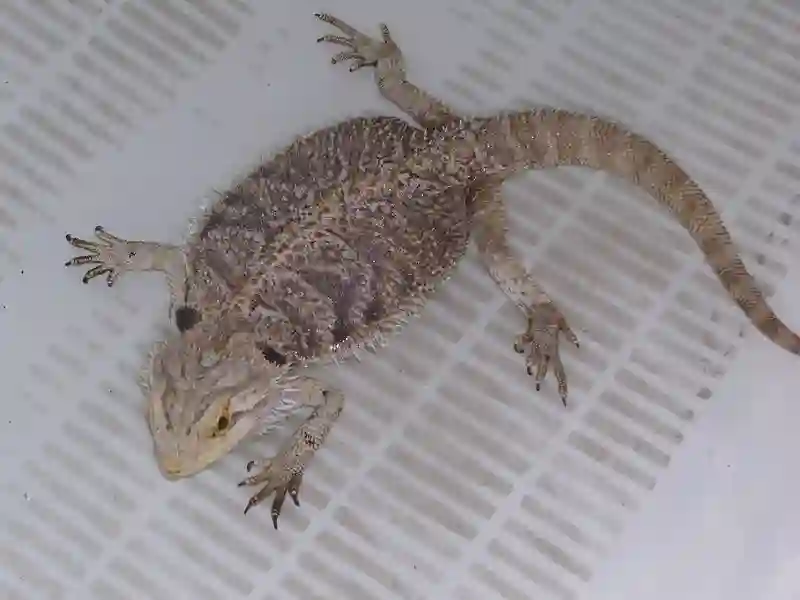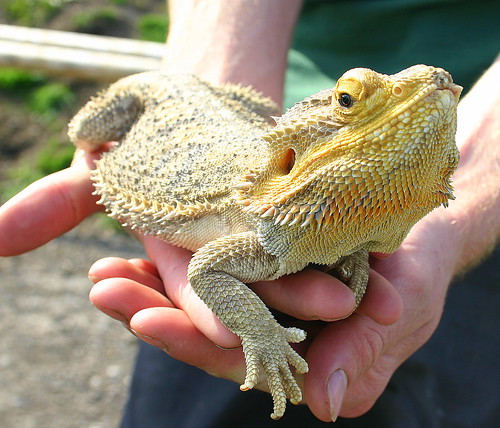Reptile experts agree that bearded dragons are fascinating creatures to keep as pets. While these animals require a great deal of care, they do not demand too much attention and can live happily in captivity for years.
However, one common issue faced by owners is the presence of a nose plug on their pet’s snout. This can be concerning but thankfully, there are ways to remove it safely without causing any harm to your dragon. In this article, we will discuss how to properly remove a beard dragon’s nose plug so that you can provide your pet with the best possible care.
Causes of Nose Plugs in Bearded Dragons
The nose plugs in bearded dragons are primarily caused by an accumulation of mucus and debris within their nostrils. Mucus production is a normal process that helps to keep the lining of the nasal cavity moist and protect it from harmful bacteria and foreign particles.
However, when there is an excessive amount of mucus production due to various reasons, such as a respiratory infection, dehydration, or poor husbandry practices like inadequate humidity levels or dirty conditions, it can result in the formation of nose plugs.
Additionally, if your bearded dragon frequently burrows into a substrate or has access to bedding materials that can get lodged in their nostrils like wood chips or sand, it may also contribute to nose plug formation.
Symptoms that Indicate a Nose Plug is Present
It is crucial for pet owners to be aware of several signs indicating that their bearded dragon has developed a nose plug. The most common symptom is wheezing or noisy breathing sounds due to the inability to breathe through both nostrils properly.
You may also notice your pet scratching at its nose frequently with its paws or against hard surfaces like rocks or logs in its enclosure as they try to relieve any discomfort caused by the blockage.
Another sign could be sneezing repeatedly throughout the day and discharge coming out from only one nostril indicating there may be a blockage on either side of the nostril.
If you suspect your pet has a nose plug but you are unsure how severe it might be, consult with a reptile vet who will determine what needs to happen next based on symptoms shown by identifying which side(s) are blocked by examining your pet’s nasal passages closely with special equipment.
Preparing for Removal
Gathering necessary supplies (cotton swabs, warm water, tweezers)
When removing a bearded dragon’s nose plug, it is essential to have the necessary tools at hand. Cotton swabs are excellent for wiping away any mucus that may be present in the nostril, while warm water helps soften and loosen up the plug.
Tweezers are also essential in carefully extracting the nose plug from the bearded dragon’s nostril. It is crucial to ensure that all tools used during this process are clean and sterilized to prevent any possible infections.
Creating a comfortable and safe environment for the bearded dragon
Before starting to remove a nose plug from a bearded dragon, it is vital to make sure that they feel comfortable and safe. The process can cause stress on your pet because it may involve restraining them slightly.
Therefore, you should choose an appropriate location that provides ample space to work and ensures minimal distractions or interruptions. Covering your pet’s body with a light towel will provide them with some comfort while also preventing them from moving around excessively during the removal process.
Additionally, be sure to provide adequate lighting so you can see what you’re doing clearly. Once everything is set up correctly, approach your pet calmly and gently so as not to startle them.
Speak softly and reassure your bearded dragon if they seem agitated or anxious. Remember that patience is key when dealing with reptiles; take your time throughout this process until you achieve success safely without causing any harm or discomfort to your beloved pet!
Removing the Nose Plug
Softening the Plug with Warm Water
To begin removing a nose plug from your bearded dragon’s nostril, it is important to first soften the plug. You can do this by using warm water. First, fill a small bowl with warm water – not too hot, but comfortably warm to the touch.
Then, you will need to gently use a cotton swab or cloth to moisten the area around the nostril and on top of the plug itself. This will help loosen any dried mucus and make it easier to remove.
Gently Using Cotton Swabs to Remove Excess Mucus
Once you have softened the nose plug with warm water, it is time to gently remove any excess mucus from around the nostril area. Use a clean cotton swab or cloth, dipped in warm water if needed, and gently wipe away any visible discharge on or around the nose plug.
It is important that you do not push too hard or irritate your bearded dragon’s nostrils as this can cause further discomfort and complications. If your bearded dragon seems agitated or stressed during this process, take a break and allow them to calm down before continuing.
Using Tweezers to Carefully Extract the Plug
You will need to use tweezers in order to carefully extract the nose plug itself. Be sure that your tweezers are clean and sanitized before use – you don’t want any bacteria or germs getting into your bearded dragon’s delicate nasal passages.
With one hand holding your bearded dragon steady and still, use your other hand and tweezers to grasp onto the nose plug firmly but gently – taking care not to squeeze too hard. Apply slow pressure while pulling outward until you feel resistance from inside its nasal passage – at which point you should stop and leave the plug alone.
If you find that the nose plug is especially stubborn or difficult to remove, consider using a few drops of saline solution to help further soften the plug and make it easier to extract.
As always, be very careful not to cause any trauma or discomfort to your bearded dragon while performing this procedure – and if in doubt, seek advice from a veterinarian.
Aftercare
Providing Clean Water and Food
After removing the nose plug, it’s important to provide your bearded dragon with clean water and food. A clean environment is also crucial in ensuring their recovery. Make sure to replace their water dish regularly and clean any leftover food that they may have not eaten.
Keep in mind that your bearded dragon may not want to eat right away after the procedure, so it’s important not to force-feed them. Stick to their usual feeding routine, but also monitor their appetite for any changes.
Monitoring Their Behavior and Health
It’s important to keep a close eye on your bearded dragon’s behavior and health after removing the nose plug. Check for any signs of discomfort, such as sneezing or scratching around the nostrils. If you notice any abnormal behavior or physical symptoms, contact your veterinarian immediately.
Monitor their bowel movements as well because if they are unable to properly breathe through their nostrils due to a clogged nose, they might eat less and drink more water which might cause diarrhea.
If necessary, keep a record of their eating habits, weight changes, and other notable behaviors during this time period; this will help you determine if there are any further issues with your bearded dragon’s health that need attention from a veterinarian.
It is normal for some mucus buildup in your Beardies nostrils but should clear up within one day post-procedure. However, if you notice an accumulation of phlegm then do contact a vet rather than trying anything on your own as it can lead to complications later on.
Overall, providing proper aftercare is crucial in ensuring the health and well-being of your bearded dragon after removing a nose plug. Keep an eye out for any warning signs or changes in behavior, stay on top of cleaning routines & monitor food & drink intake post-procedure; the aim is always to keep them healthy and happy.
Prevention Tips
The Importance of Preventing Nose Plugs
Preventing nose plugs in bearded dragons is essential to ensure their optimal health and well-being. As previously discussed, nose plugs can lead to respiratory difficulties and infections, which can quickly become serious if left untreated. Therefore, it is crucial to take preventative measures to avoid the formation of nose plugs in your bearded dragon.
Keeping the Habitat Clean
One effective way to prevent nose plugs from forming in your bearded dragon is by keeping their habitat clean. This includes regularly cleaning their enclosure, disinfecting surfaces, and removing any fecal matter or excess food promptly. A clean environment will help minimize bacterial growth that could cause mucus accumulation and blockages.
Maintaining Proper Humidity Levels
Proper humidity levels are essential for preventing nose plugs in bearded dragons. These reptiles require a certain level of moisture in their environment, but excessive moisture can lead to mucus buildup and respiratory issues.
The ideal humidity range for a bearded dragon is between 30% and 40%. To maintain proper levels, ensure that there is proper ventilation and avoid over-misting or over-watering.
Optimizing Diet and Nutrition
Bearded dragons require a balanced diet consisting of appropriate amounts of protein and vegetables. A healthy diet provides essential nutrients that help support their immune system and overall well-being. It’s important also not to feed them insects that are too large as they may cause impaction which contributes towards mucus build-up inside the nostrils.
Regular Health Checks
Performing regular health checks on your bearded dragon can help detect any potential issues before they become serious problems.
This includes monitoring for any symptoms or indications of respiratory distress such as wheezing, coughing, or discharge from the nostrils. Regular checkups can help you catch any potential issues early on, allowing you to take appropriate measures to prevent nose plugs and other respiratory problems.
Conclusion
Recap of Steps on How to Remove a Bearded Dragon’s Nose Plug Safely and Effectively
Removing a nose plug from a bearded dragon can be a delicate process, but with careful attention to detail and adequate preparation, it can be done safely and effectively. To recap, the first step is to gather all necessary supplies, including cotton swabs, warm water, and tweezers.
The second step is to create a comfortable environment for the bearded dragon by ensuring they are relaxed and supported properly. Then, you’ll want to take your time removing the nose plug by softening it with warm water, gently using cotton swabs to remove excess mucus and debris, then carefully using tweezers to extract the plug.
After successfully removing the nose plug from your bearded dragon’s nostril, it’s important that you monitor their behavior and health closely. Check for any signs of discomfort or infection in the days following removal.
You should also provide your bearded dragon with clean water and food during this time. To prevent future nose plugs from forming in your bearded dragon, consider providing them with regular baths or misting their enclosure more frequently.
Additionally, make sure their habitat is kept clean and free of debris that could contribute to nasal blockages. Overall, while removing a nose plug from a bearded dragon may seem daunting at first glance, taking the proper steps can help ensure success without harm or discomfort for your pet.


